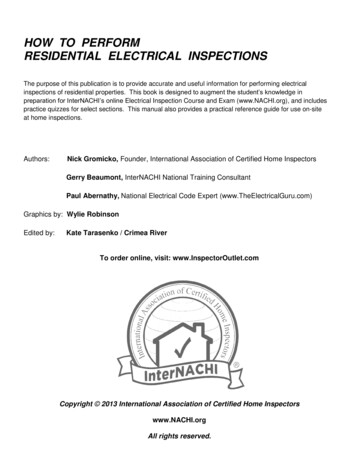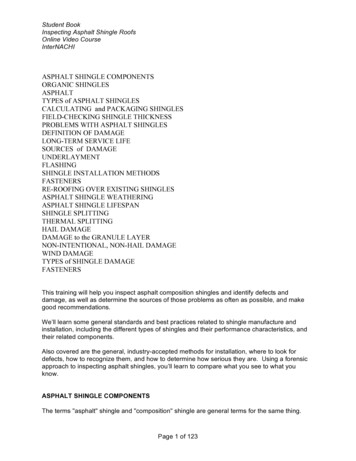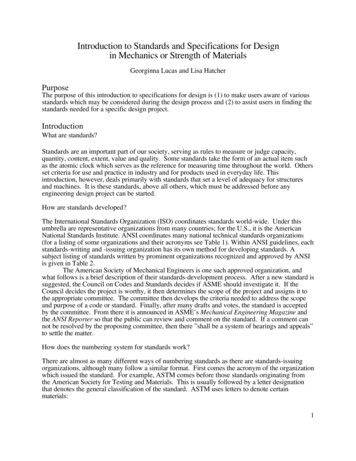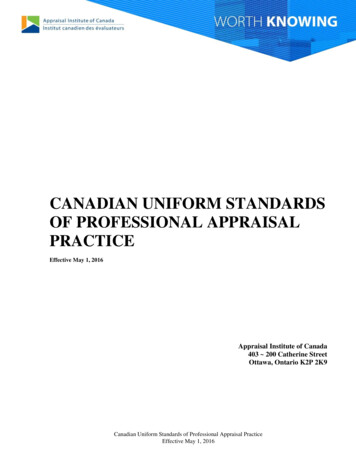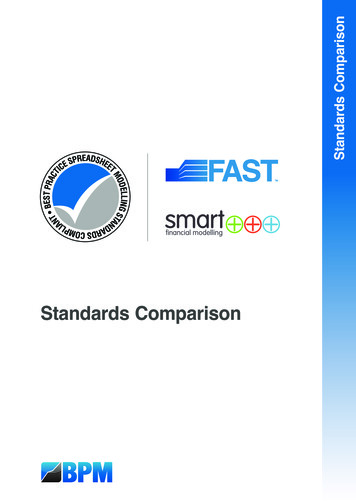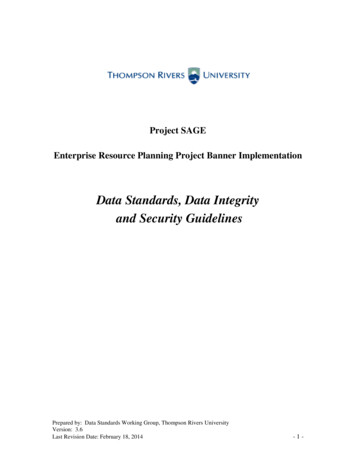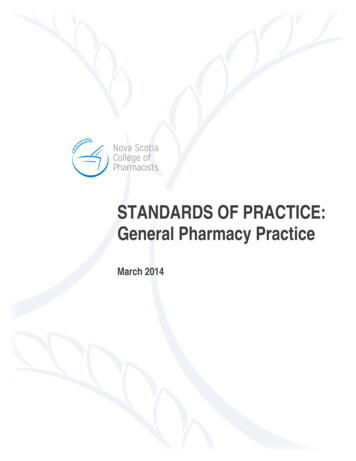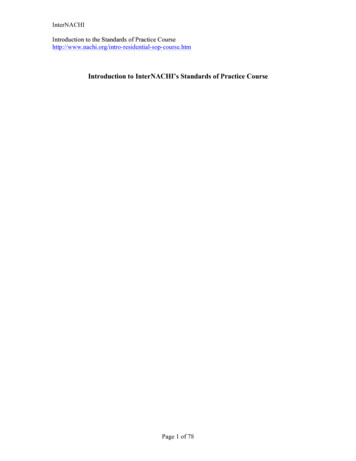
Transcription
InterNACHIIntroduction to the Standards of Practice ourse.htmIntroduction to InterNACHI’s Standards of Practice CoursePage 1 of 78
InterNACHIIntroduction to the Standards of Practice ourse.htmStudent Verification and InteractivityStudent VerificationBy enrolling in this course, the student hereby attests that s/he is the person completingall coursework. S/he understands that having another person complete the coursework forhim or her is fraudulent and will result in being denied course completion andcorresponding credit hours.The course provider reserves the right to make contact asnecessary to verify the integrity of any information submittedor communicated by the student. The student agrees not toduplicate or distribute any part of this copyrighted work orprovide other parties with the answers or copies of theassessments that are part of this course. If plagiarism orcopyright infringement is proven, the student will be notifiedof such and barred from the course and/or have his/her credithours and/or certification revoked.Communication on the message board or forum shall be ofthe person completing all coursework.InteractivityInteractivity between the student and the course provider is made by the opportunity tocorrespond via email. Students will receive a timely response within 24 hours during thework week and by close of business on Monday for questions received over the weekend.The student can join in the conversation with other students by visiting the online forumdedicated to this course. Students are free to post questions and comments there. Thethread will be monitored by the course instructor.Need Help?At any time, you may email Director of Education Ben Gromicko at ben@internachi.org.Page 2 of 78
InterNACHIIntroduction to the Standards of Practice ourse.htmExceeding the Standards of Practiceby InterNACHI's Legal Counsel Mark Cohen and InterNACHI Founder Nick GromickoInspectors sometimes ask about the potential legal consequences if their inspections gobeyond what InterNACHI’s Standards of Practice (SOP) require.Of course, every inspection must, at a minimum, substantially meet the requirements ofthe SOP. If an inspector fails to comply with the SOP, the customer would have validclaims against the inspector for breach of contract and misrepresentation.Therefore, when in doubt about what the SOP requires in a particular situation, theinspector should err on the side of caution and exceed what the SOP requires. It is betterto do a little more than what may be required than to do less and risk a potential claimand harm to your reputation.A word of caution: if an inspector consistently goes far beyond what the SOP requires, acustomer might successfully argue that the inspector voluntarily assumed a duty greaterthan the contract required. Most inspection contracts contain language stating that theinspector will perform the inspection in accordance with InterNACHI’s SOP. Aninspector who goes far beyond what the SOP requires may open himself up to a claimthat there was an oral agreement that he was going to do a more rigorous inspection thanwhat's required by the SOP.If an inspector voluntarily assumes a duty greater than the duty required by the contract,the inspector has an obligation to perform those additional tasks with reasonable care.Page 3 of 78
InterNACHIIntroduction to the Standards of Practice ourse.htmIntroductionThis course is designed to review InterNACHI's Standards of Practice for Performing aGeneral Home Inspection.Many slides in this course contain images that can be enlarged by clicking on the imageor on a link below the image.Most of the terminology contained in the Standards can be found within the glossary atthe end of this course.After each section, there is a brief quiz to test your understanding of the coursecontent. The quizzes are multiple-choice and are designed to give you guidance in areasthat you may need to review again. Sections can be accessed using the "Previous Page"button and the "Next Page" button at the bottom of each page, or you can use thenavigation bar on the left side of each page.The Standards of Practice are not exhaustive and cover only the minimumrequirements that an InterNACHI member must follow for a general homeinspection. Your state or province may have adopted licensing and their own Standardsof Practice that you must also follow in order to keep your license active and in goodstanding. Please take the time to read and understand InterNACHI's Standards ofPractice for Performing a General Home Inspection before taking this course.This course mirrors InterNACHI's Standards of Practice and covers:1. Definitions and Scope2. Limitations, Exceptions & Exclusions3. Standards of Practice3.1. Roof3.2. Exterior3.3. Basement, Foundation, Crawlspace & Structure3.4. Heating3.5. Cooling3.6. Plumbing3.7. Electrical3.8. Fireplace3.9. Attic, Insulation & Ventilation3.10. Doors, Windows & InteriorPage 4 of 78
InterNACHIIntroduction to the Standards of Practice ourse.htm4. Glossary of TermsPage 5 of 78
InterNACHIIntroduction to the Standards of Practice ourse.htm1. Definitions and Scope1.1. A general home inspection is a non-invasive, visual examination of the accessibleareas of a residential property (as delineated below), performed for a fee, which isdesigned to identify defects within specific systems and components defined by theseStandards that are both observed and deemed material by the inspector. The scope ofwork may be modified by the Client and Inspector prior to the inspection process.· component: A permanently installed or attached fixture, element or part of a system.· general home inspection (also, home inspection and standard home inspection): Theprocess by which an inspector visually examines the readily accessible systems andcomponents of a home and operates those systems and components utilizing theseStandards of Practice as a guideline.· inspect: To examine readily accessible systems and components safely, usingnormal operating controls, and accessing readily accessible areas, in accordancewith these Standards of Practice.A non-invasive, visual examination relates to the fact that, in most cases, homeinspectors are not required to dismantle or remove components, with the oneexception being the removal of electrical panel covers (dead fronts). A residentialproperty can include apartments, condos, single-family homes, and structurescontaining multiple units. However, some authorities limit these to a building with amaximum of four units. Any inspection must include an agreement between theinspector and the client as to which components and systems the inspector will beevaluating.I. The general home inspection is based on the observations made on the date of theinspection, and not a prediction of future conditions. condition: The visible and conspicuous state of being of an object.evaluate: To assess the systems, structures and/or components of a property.inspected property: The readily accessible areas of the buildings, site, items,components and systems included in the inspection.Remember that, as an inspector, you can only report on what you can see, givenreasonable access.II. The general home inspection will not reveal every issue that exists or ever couldexist, but only those material defects observed on the date of the inspection.Page 6 of 78
InterNACHIIntroduction to the Standards of Practice ourse.htm1.2. A material defect is a specific issue with a system or component of a residentialproperty that may have a significant, adverse impact on the value of the property,or that poses an unreasonable risk to people. The fact that a system or component isnear, at or beyond the end of its normal useful life is not, in itself, a material defect. unsafe: In the inspector's opinion, a condition of an area, system,component or procedure that is judged to be a significant risk of injuryduring normal, day-to-day use. The risk may be due to damage,deterioration, improper installation, or a change in accepted residentialconstruction standards.For example, a cracked foundation or a dangerous electrical condition wouldconstitute a material defect, but a roof covering that had exceeded its intendedlifespan would not, unless it was also showing signs of leakage.1.3. A general home inspection report shall identify, in written format, defectswithin specific systems and components defined by these Standards that are bothobserved and deemed material by the inspector. Inspection reports may includeadditional comments and recommendations. report: (verb form) To express, communicate or provide information inwriting; give a written account of.inspection report: A written communication (possibly including images) ofany material defects observed during the inspection.Page 7 of 78
InterNACHIIntroduction to the Standards of Practice ourse.htmQuiz #1: Definitions and ScopeA home inspection is a(n) .non-invasive visual examination of a commercial propertynon-invasive, visual examination of the accessible areas of a residential propertyinvasive, visual examination of a residential dwellingT/F: An issue that would be considered a safety hazard would also be considered amaterial defect.FalseTrueA component is defined as .something attached to something elsea permanently installed or attached fixturea temporarily installed or attached fixtureAlthough not always required, home inspectors normally remove the covers on.enclosed plumbing chasesboilers and furnaceselectrical panelsAn inspection report may include .all of theseadditional comments beyond identified material defectsimagesrecommendationsA residential building with up to units is covered by this SOP.10fourtwoPage 8 of 78
InterNACHIIntroduction to the Standards of Practice ourse.htmT/F: A material defect is one that could seriously affect the home's value.FalseTrueA home inspector must produce a report regarding his/her observations ofthe condition of the property.writtenverbalT/F: A home inspector is required to report on the future condition of the structure.TrueFalsePage 9 of 78
InterNACHIIntroduction to the Standards of Practice ourse.htm2. Limitations, Exceptions & Exclusions2.1. Limitations:I.II.III.IV.V.VI.VII.VIII.IX.X.An inspection is not technically exhaustive.An inspection will not identify concealed or latent defects.An inspection will not deal with aesthetic concerns or what could bedeemed matters of taste, cosmetic defects, etc.An inspection will not determine the suitability of the property for any use.An inspection does not determine the market value of the property or itsmarketability.An inspection does not determine the insurability of the property.An inspection does not determine the advisability or inadvisability of the purchaseof the inspected property.An inspection does not determine the life expectancy of the property or anycomponents or systems therein.An inspection does not include items not permanently installed.These Standards of Practice apply only to properties with four or fewer residentialunits.·2.2. Exclusions:I. The inspector is not required to determine:A.B.C.D.E.F.G.H.I.J.K.L.M.N.O.property boundary lines or encroachments.the condition of any component or system that is not readily accessible.the service life expectancy of any component or system.the size, capacity, BTU, performance or efficiency of any component or system.the cause or reason of any condition.the cause for the need of correction, repair or replacement of any system orcomponent.future conditions.compliance with codes or regulations.the presence of evidence of rodents, birds, animals, insects, or other pests.the presence of mold, mildew or fungus.the presence of airborne hazards, including radon.the air quality.the existence of environmental hazards, including lead paint, asbestos or toxicdrywall.the existence of electromagnetic fields.any hazardous waste conditions.Page 10 of 78
InterNACHIIntroduction to the Standards of Practice ourse.htmP. any manufacturers' recalls or conformance with manufacturer installation, or anyinformation included for consumer protection purposes.Q. acoustical properties.R. correction, replacement or repair cost estimates.S. estimates of the cost to operate any given system.II. The inspector is not required to operate:A. any system that is shut down.B. any system that does not function properly.C. or evaluate low-voltage electrical systems such as, but not limited to:1. phone lines;2. cable lines;3. satellite dishes;4. antennae;5. lights; or6. remote controls.D.E.F.G.H.any system that does not turn on with the use of normal operating controls.any shut-off valves or manual stop valves.any electrical disconnect or over-current protection devices.any alarm systems.moisture meters, gas detectors or similar equipment.III. The inspector is not required to:A. move any personal items or other obstructions, such as, but not limited to: throwrugs, carpeting, wall coverings, furniture, ceiling tiles, window coverings,equipment, plants, ice, debris, snow, water, dirt, pets, or anything else that mightrestrict the visual inspection.B. dismantle, open or uncover any system or component.C. enter or access any area that may, in the opinion of the inspector, be unsafe.D. enter crawlspaces or other areas that may be unsafe or not readily accessible.E. inspect underground items, such as, but not limited to: lawn-irrigation systems,underground storage tanks or other indications of their presence, whetherabandoned or actively used.F. do anything which may, in the inspector's opinion, be unsafe or dangerous to theinspector or others, or damage property, such as, but not limited to: walking onroof surfaces, climbing ladders, entering attic spaces, or negotiating with pets.G. inspect decorative items.H. inspect common elements or areas in multi-unit housing.I. inspect intercoms, speaker systems or security systems.J. offer guarantees or warranties.Page 11 of 78
InterNACHIIntroduction to the Standards of Practice ourse.htmK. offer or perform any engineering services.L. offer or perform any trade or professional service other than general homeinspection.M. research the history of the property, or report on its potential for alteration,modification, extendibility or suitability for a specific or proposed use foroccupancy.N. determine the age of construction or installation of any system, structure orcomponent of a building, or differentiate between original construction andsubsequent additions, improvements, renovations or replacements.O. determine the insurability of a property.P. perform or offer Phase 1 or environmental audits.Q. inspect any system or component that is not included in these Standards.Page 12 of 78
InterNACHIIntroduction to the Standards of Practice ourse.htmQuiz #2: LimitationsT/F: A home inspection report should include comments based on the decor.FalseTrueT/F: An inspection report should not comment on the property's possiblecommercial use.FalseTrueT/F: Home inspectors are required to move furniture when needed.TrueFalseT/F: A home inspection report is a warranty of components and systems.TrueFalseThe home inspector is required to determine .the presence of mildewthe presence of moldboth of theseneither of theseT/F: Home inspectors are required to evaluate unsafe parts of the structure.FalseTrueA home inspection report must include identification of the presence of.none of theseall of theselead paintPage 13 of 78
InterNACHIIntroduction to the Standards of Practice ourse.htmradonasbestosT/F: The inspection report should include a determination of whether any additionswere completed to code.TrueFalseT/F: Repair estimates are not required in the inspection report.TrueFalseT/F: Inspectors are not required to check for compliance with local codes orregulations.FalseTruePage 14 of 78
InterNACHIIntroduction to the Standards of Practice ourse.htmSection 3.1. RoofEnlargeIncluded in inspecting the roof arethe roof-covering materials,sheathing and guttering systems.The roof is the second largest area ofinspector liability, and it's notalways an easy area to assessproperly.3.1. RoofI. The inspector shall inspect fromground level or the eaves:A.B.C.D.E.the roof-covering materials;the gutters;the downspouts;the vents, flashing, skylights, chimney and other roof penetrations; andthe general structure of the roof from the readily accessible panels, doors or stairs.While the SOP requires inspectors to inspect the roof, how this is accomplished dependson the inspector's comfort level; many inspectors never walk a roof. In many cases, thesafest way to examine a roof is from a ladder at the eaves. (Refer to InterNACHI's SafePractices for the Home Inspector course.)An examination of the roof helps identify the type of material used (slate, asphalt shingle,wood shake, roll roofing, etc.). Based on a visual inspection, a determination can bemade as to its general condition, as well as any problems or deficiencies.Page 15 of 78
InterNACHIIntroduction to the Standards of Practice ourse.htmInspecting the guttering, as well as noting its material, condition and attachment, mayalso give visual clues as to the condition of the roof. (For example, is the gutter full ofaggregate from worn asphalt shingles?)Downspouts are a critical part of the gutter system; they should be properly connected toboth the guttering and the structure, and, when discharging above grade, should bediverting water well away from the structure and the foundation.Vents, flashings, skylights, etc., canbe a significant problem, as they areall engineered holes in the roofcovering. If not properly installed ormaintained, they may allow rainwaterto enter the sheathing and/or atticspace. Some components, such as thechimney cricket, can be difficult toevaluate from up close.II. The inspector shall describe:A. the type of roof-coveringmaterials.III. The inspector shall report as in need of correction:A. observed indications of active roof leaks.Evaluating the roof structure is best done from inside the attic space (with safe access);it is an extremely important part of the inspection. Inspectors must check the undersideof the sheathing for signs of moisture penetration, looking closely at roof penetrations forsigns of flashing failure, and obvious signs of structural problems, such as split raftersand improperly cut roof-truss systems.IV. The inspector is not required to:A.B.C.D.walk on any roof surface.predict the service life expectancy.inspect underground downspout diverter drainage pipes.remove snow, ice, debris or other conditions that prohibit the observation of theroof surfaces.E. move insulation.Page 16 of 78
InterNACHIIntroduction to the Standards of Practice ourse.htmF. inspect antennae, satellite dishes, lightning arresters, de-icing equipment, orsimilar attachments.G. walk on any roof areas that appear, in the opinion of the inspector, to be unsafe.H. walk on any roof areas if it might, in the opinion of the inspector, cause damage.I. perform a water test.J. warrant or certify the roof.K. confirm proper fastening or installation of any roof-covering material.As discussed previously, walking a roof is a matter of choice, but some roof coveringscan be easily damaged by careless inspection. With materials such as slate, tile, and sometypes of shingles, an inspector can crack or dislodge parts of the covering.Predicting life expectancy of any component can be very risky, and roofing materialsmake that task more difficult still. A standard asphalt shingle roof, for example, hasa lifespan that is dependent on prevailing weather, overhanging trees, the number oflayers of covering, and adequate ventilation, to name but a few factors.Underground downspout terminations fall into the "If you can't see it, you can't report it"category. Often, the drainage system has failed due to silting up, root system blockages,or collapsed pipe work.It is also unsafe to walk most roofs when they are wet, icy, snow-covered ormossy. Removing snow, ice or debris to inspect the roof is hazardous, similar to beingup on the roof in adverse weather conditions.Inspecting antennae, satellite dishes, and similar items is not required, but a competentinspector will check their attachment to the fixed systems of the roof, such aschimneys and through-the-roof mountings.Recommended: InterNACHI's Roof Inspection course.Page 17 of 78
InterNACHIIntroduction to the Standards of Practice ourse.htmQuiz #3: RoofT/F: Home inspectors are required to walk every roof.FalseTrueneed not be inspected.SkylightsRoof vents and flashingsTelevision antennae and satellite dishesDownspoutsT/F: Inspectors are required to gain access to all attic spaces.FalseTrueT/F: The inspector is required to report on the visible condition of the roof-coveringmaterials.TrueFalseThe condition of need not be reported.the downspoutsthe gutteringunderground drainageT/F: Home inspectors are trained to determine the future life expectancy of roofcovering materials.TrueFalseWhich of the following should the inspector remove prior to evaluating the roof?leavesnone of thesedebrisPage 18 of 78
InterNACHIIntroduction to the Standards of Practice ourse.htmsnow and iceall of theseSection 3.2. ExteriorEnlargeThis section includes the exterior of the home, the components that are attached to it, andthe lot that it sits on.3.2. ExteriorI. The inspector shall inspect:A.B.C.D.E.F.G.H.I.the exterior wall-covering material, flashing and trim;all exterior doors;adjacent walkways and driveways;stairs, steps, stoops, stairways and ramps;porches, patios, decks, balconies and carports;railings, guards and handrails;the eaves, soffits and fascia;a representative number of windows; andvegetation, surface drainage, retaining walls and grading of the property, whenthey may adversely affect the structure due to moisture intrusion.Many inspectors start with a walk around the structure, taking notes as well as photos,and looking closely at the structure for walls out of plumb, whether a chimney is leaning,etc., and generally getting the feel of the home. Many things that are observed outside areclues to greater issues with the property. The exterior itself can be very complicated, withPage 19 of 78
InterNACHIIntroduction to the Standards of Practice ourse.htmmultiple components and systems. All exterior systems should be thoroughlyevaluated.Wooden components are susceptible to rot, particularly when they are installed neargrade or just under the roof line. For example, exterior flashings and trim are typicallyproblematic issues even on an otherwise well-maintained home. It is not unusual to seetrim rotted away due to poor installation of flashings. It is unusual to find a garage doorframe without rot. The attachment of any exterior component should be checked,particularly decks, stoops, steps and stairs, many of which show signs of inadequateattachment and poor flashing.A major safety concern of steps anddecks is the lack of properguardrails and handrails. Even whenpresent, they are often found tobe unsafe due to design or inadequateinstallation or attachment.II. The inspector shall describe:A. the type of exterior wallcovering materials.B. as in need of correction anyimproper spacing betweenintermediate balusters,spindles and rails.III. The inspector shall report as in need of correction:A. any improper spacing between intermediate balusters, spindles and rails.Competent inspectors also evaluate the lot and grounds of the home, and report on treesthat pose a threat to the structure, retaining walls that are damaged or rotten, footpathsand walkways that present a trip hazard, and the general topography of the site and itsability to drain surface water.Every inspection report should detail the type and materials of the home'scomponents and systems. The report should show what the exterior wall structure ismade of and how it is covered. An example of this might be: "Frame constructed withvinyl siding," or brick veneer, or solid masonry, etc.As a side note, InterNACHI's Residential SOP does not require inspectors to evaluatedetached garages. However, many inspectors do so as part of their exterior inspection,Page 20 of 78
InterNACHIIntroduction to the Standards of Practice ourse.htmand some are further required to include garages in their general home inspections, asmandated by their state. In this case, inspectors should note the same types of defects asdescribed for the home's exterior structure in general. InterNACHI provides usefulguidelines in its How to Inspect the Exterior course (Section 31: Inspecting a Garage), aswell as an article title A Garage Inspection. Inspectors should further note that, accordingto the NEC (210.8A2), all garages are now required to have GFCI-protected electricalreceptacles/outlets, and the absence of them should be called out and noted in theinspection report.IV. The inspector is not required to:A. inspect or operate screens, storm windows, shutters, awnings, fences,outbuildings, or exterior accent lighting.B. inspect items that are not visible or readily accessible from the ground, includingwindow and door flashing.C. inspect or identify geological, geotechnical, hydrological or soil conditions.D. inspect recreational facilities or playground equipment.E. inspect seawalls, breakwalls or docks.F. inspect erosion-control or earth-stabilization measures.G. inspect for safety-type glass.H. inspect underground utilities.I. inspect underground items.J. inspect wells or springs.K. inspect solar, wind or geothermal systems.L. inspect swimming pools or spas.Page 21 of 78
InterNACHIIntroduction to the Standards of Practice ourse.htmM.N.O.P.inspect wastewater treatment systems, septic systems or cesspools.inspect irrigation or sprinkler systems.inspect drainfields or dry wells.determine the integrity of multiple-pane window glazing or thermal window seals.Page 22 of 78
InterNACHIIntroduction to the Standards of Practice ourse.htmQuiz #4: ExteriorAn inspector is not required to report on the siding's .conditionflashingsmaterialcolorT/F: An inspector should report on vegetation around the home when it mayadversely affect the structure due to moisture intrusion.TrueFalseAn inspector is required to report all of the following elements of a deck, except its.supportsflashingfurnitureattachmentT/F: An inspector should report on the condition of soffit trim.FalseTrueT/F: The home inspector should report on whether the home is in an area of seismicactivity.TrueFalseT/F: An inspector should estimate the depth of a property's local groundwater table.FalseTruePage 23 of 78
InterNACHIIntroduction to the Standards of Practice ourse.htmT/F: The home inspector should confirm that the lot lines conform with theproperty's legal description or listing details.TrueFalsePage 24 of 78
InterNACHIIntroduction to the Standards of Practice ourse.htmSection 3.3: Basement, Foundation, etc.EnlargeThis section covers all of the visible structural elements of a residential property. It isvital to understand these systems, as they pose the greatest liability for a home inspector.(Remember that this course is about the Standards and not about how to inspect thevarious systems themselves. Take InterNACHI's Structural Issues for Home Inspectorscourse.)3.3. Basement, Foundation, Crawlspace & StructureI. The inspector shall inspect:A.B.C.D.the foundation;the basement;the crawlspace; andstructural components.This section covers many different building types. In some parts of the U.S., homesare usually built on slabs; in other regions, the majority are built with fullPage 25 of 78
InterNACHIIntroduction to the Standards of Practice ourse.htmbasements. Similarly, some areas have primarily stick-built structures, while others useconcrete block, brick or adobe.In all cases, the inspector is required to report on the visible structure only and report onthe material and type of foundation (e.g. poured concrete slab or concrete blockfoundation). Also, the wall structure and materials should be reported when they can bedetermined.When evaluating the structure, one ofthe biggest problems is moistureseeping into it. Sometimes, it isobvious, such as when there is waterpooling on the floor. Often, the signsare more subtle, such as efflorescenceor staining of the interior trim. Allaccessible areas should be inspected forsigns of moisture. When indications ofmoisture intrusion are found, thoseareas should be probed, examinedfurther, and reported as in need offurther evaluation to determine the extent of any potential dama
This course is designed to review InterNACHI's Standards of Practice for Performing a General Home Inspection. Many slides in this course contain images that can be enlarged by clicking on the image or on a link below the image. Most of the terminology contained in the Standards can be found within

